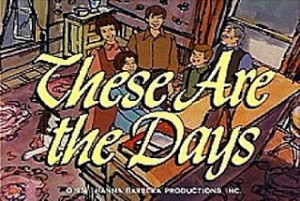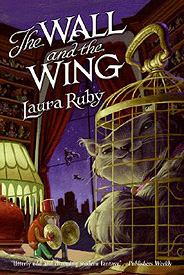
Hakujaden (aka “The Legend of White Snake” or “The White Snake Enchantress”) was released in the U.S. in 1961 as “Panda And The Magic Serpent”
“I have to make an embarrassing confession. I fell in love with the heroine of a cartoon movie. My soul was moved and I stumbled back home in the snow that had just started. Comparing my pitiful situation to the characters’ earnestness, I was ashamed of myself and cried all night. The meeting with Hakujaden left a strong impression on me, who was still immature at that time.
“It made me realize what a fool I was, who was trying to be a manga writer by writing an absurd drama which was in fashion at that time. It made me realize that despite the words of distrust I spoke, I yearned for such an earnest and pure world though it may be a cheap melodrama. I could no longer deny the fact that I really wanted to affirm the world. I came to think seriously about what I should make. I came to think that I should work with my true heart, even if that’s embarrassing.
“I wanted to make clear where I stand. Today, I can’t talk about our business without some bitterness. Compared to several works in the 1950s which inspired me, we in the 1980s make animation as if it’s an in-flight meal served on a Jumbo Jet. The true emotion and feeling that should be carried through have been replaced by bluff, neurosis or teasing.”
 Action, Entertainment and Noise. From the book “Inside the TV Business (1979) by Paul Klein and Steve Morgenstern, Hanna-Barbera legend Joe Barbera talked about how quality animation didn’t necessarily receive the ratings it needed to continue.
Action, Entertainment and Noise. From the book “Inside the TV Business (1979) by Paul Klein and Steve Morgenstern, Hanna-Barbera legend Joe Barbera talked about how quality animation didn’t necessarily receive the ratings it needed to continue.
“It doesn’t mean a darn thing to the kids, whether I put 40,000 drawings in or 400 or 4,000 as long as the entertainment is up there. They’re not aware that when a man is running, his foot hits the ground, and his knee bends and his muscle quivers and his hair jumps. That doesn’t mean a thing to them, really.
“On Saturday morning, you must give them action and entertainment and noise. We did a show called These Are the Days for which we received kudos, handshakes, and pats on the head from all the organizations. It was a family show like The Waltons and the kids are switching to Batman. We got all the good notices but we didn’t get the rating points. And if you don’t get the rating points, all the work goes down the tubes…goodbye… cancel the show.”
Early Kricfalusi. From AV Club/The Onion March 4, 2001 Volume 37, Issue 12, animator and director John Kricfalusi remembered his first animation work: “At Filmation I was working on the really, really hideous stuff like Fat Albert and the Cosby Kids. But, actually, the first cartoons I worked on at Filmation were re-dos of Mighty Mouse and Heckle and Jeckle. So that was my introduction to ruining old characters that I loved when I was a kid. The next year we ruined Tom & Jerry and Droopy and a few years later, I got to ruin The Jetsons. I actually tried to save it while I was working on it, but it was pretty hard because the whole thing was set up to ruin them.
 “Hanna-Barbera invented these new characters in a completely different style that has nothing to do with the original characters. “Orbitty” was there because ‘E.T.’ had just hit it big a couple something years before and they wanted to make sure the kids like The Jetsons. They figure the Jetsons would be too old-fashioned by themselves, so they say, ‘Let’s get this ugly character in there. E.T.’s really ugly but the kids loved him, so we’ll put an ugly character in here!’ Ouch! Every chance I got, I’d have Astro accidentally step on his head, get him crushed under the couch. Everything I could do to get that thing out of the way.
“Hanna-Barbera invented these new characters in a completely different style that has nothing to do with the original characters. “Orbitty” was there because ‘E.T.’ had just hit it big a couple something years before and they wanted to make sure the kids like The Jetsons. They figure the Jetsons would be too old-fashioned by themselves, so they say, ‘Let’s get this ugly character in there. E.T.’s really ugly but the kids loved him, so we’ll put an ugly character in here!’ Ouch! Every chance I got, I’d have Astro accidentally step on his head, get him crushed under the couch. Everything I could do to get that thing out of the way.
“They sent me overseas to Taiwan to supervise fifteen episodes of The Jetsons there. I was kind of out of sight, so I did my best to make the drawings cool, at least. I came back waiting to be hailed as a hero. I thought they’d have a parade waiting for me. There would be a big party. A lot of people were mad at me for putting jokes in the show and making it lively. I didn’t get fired, exactly. They just didn’t give me another job. That’s when I hooked up with Ralph Bakshi.”
 The Wall and the Wing. In 2005, Vinton Studios paid a high six-figure sum for the rights to Laura Ruby’s second novel, The Wall and the Wing that would be published by HarperCollins in 2006. Henry Selick was set to direct the feature film after completing Coraline that didn’t actually get finished until 2009.
The Wall and the Wing. In 2005, Vinton Studios paid a high six-figure sum for the rights to Laura Ruby’s second novel, The Wall and the Wing that would be published by HarperCollins in 2006. Henry Selick was set to direct the feature film after completing Coraline that didn’t actually get finished until 2009.
The book was set in a Daliesque Manhattan where almost everyone can fly but one orphan finds that even though she can’t, she can turn herself invisible. The magical city had chatty birds and mind-bending monkeys, an eccentric genius with a head full of grass and a pocket full of kittens, and a giant rat man with a taste for cats.
At the time, Selick said the tale had a Dickensian feel, but he was drawn to the humor: “Not every story has an orphanage matron with a plastic surgery obsession or a bad guy who was a former child model for No Pee Pull-up Pants. Laura Ruby has an amazing sense of humor which informs each and every character.”
Bad Language. In a letter to Seth McFarlane and the team behind the Fox animated series American Dad in April 2005, Kevin Spicer (Executive Director Broadcast Standards and Practices) wanted two changes made in the episode “Deacon Stan, Jesus Man”: “Please change Father Donovan’s ‘wrap this mother up’ to read ‘wrap this bad boy up’ and to reduce the overall count of coarse language – Please lose Francine’s second use of ‘bitch’ on this page.” Two dozen people were copied on the memo.


 Jim Korkis is an internationally respected animation historian who in recent years has devoted his attention to the many worlds of Disney. He was a columnist for a variety of animation magazines. With his former writing partner, John Cawley, he authored several animation related books including The Encyclopedia of Cartoon Superstars, How to Create Animation, Cartoon Confidential and Get Animated’s Animation Art Buyer’s Guide. He taught animation classes at the Disney Institute in Florida as well as instructing classes on acting and animation history for Disney Feature Animation: Florida.
Jim Korkis is an internationally respected animation historian who in recent years has devoted his attention to the many worlds of Disney. He was a columnist for a variety of animation magazines. With his former writing partner, John Cawley, he authored several animation related books including The Encyclopedia of Cartoon Superstars, How to Create Animation, Cartoon Confidential and Get Animated’s Animation Art Buyer’s Guide. He taught animation classes at the Disney Institute in Florida as well as instructing classes on acting and animation history for Disney Feature Animation: Florida.




















































The horse and carriage from the opening of These Are the Days looks like it could have been re-used animation from the opening of Quick Draw McGraw.
Thanks for the great John K. quote and clip, a revealing anecdote.
Loved reading Miyazaki’s comments, and I agree with him. I’ve always felt that there is room for every kind of animation and type of storytelling. Animation is animation because there should be no tying it down or dumbing it down–there’s as much room for GUMBY as there is for SOUTH PARK, and animation should not “follow” strictly any pre-directed success formula, because new audiences can be drawn into your story as long as the characters are believable and it takes a lot of elements to make that character believable–an ability to “mime” when characters are not supposed to talk; I can’t tell you how many times I’ve been moved just because of a character’s body language and facial expressions (when I could see them of course), and that means moved to laughter as well as tears. I don’t agree with Barbera’s belief that kids don’t care how good the animation is. True, I watched a lot of animation and enjoyed a lot of different styles, but the animation that totally pulled me in was that which had so much detail and brilliance, whose score was amazing to listen to and whose sound effects and voice acting was as good as any live action film that was out there to pull us into the theaters or make us turn that dial on our TV’s. What can I say? I feel Miyazaki’s pain more than you know. He is to be given credit for continuing to try, but I can understand where he gave up. I get frustrated and I’m not even in the business.
Interesting post today! I’d like to know more about These Are The Days! I’ve never heard of that one before…
They had a Thanksgiving marathon along with “The Thanksgiving That Almost Wasn’t” and the movie “Charlotte’s Web” on Cartoon Network in either 1994 or 95.
I would love to hear more about “The Wall and the Wing”! How close did it come to ever being made? Can we see any art from it?
When I saw that 1987 scene from The Jetsons a couple of years ago, I knew it looked more like a 1990s “What A Cartoon!” or something of that sort. And now I know why.
Thank you for sharing this; do you know where to find the full text of the Miyazaki essay?
John Kvetchfalusi complaining about ugly animation is like Kim Kardashian calling Snooky an airhead.
Long time fan – thank you for all you do!
Regarding the Filmation re-dos of Mighty Mouse and Heckle and Jeckle (& Quacula) way back in ’79 – ’81, I actually enjoy and miss these a LOT. The animation was………….weird, but loose & very cartoony. And the scripts weren’t half bad (not surprising, since I found out that Sam Simon wrote many of them).
I am sending out an appeal to the Toon Heads across the land–does ANYONE know where one could get their grubby mitts on a collection of these shows? These are harder to find that Cletus’ brain! I’m OK with the fact that any copy I may get is not going to be top quality. I just don’t want to get scammed, and I figured the folks here would be the best experts.
If you can offer any guidance, I’d be very much appreciative.
Keep up the fantastic work!!